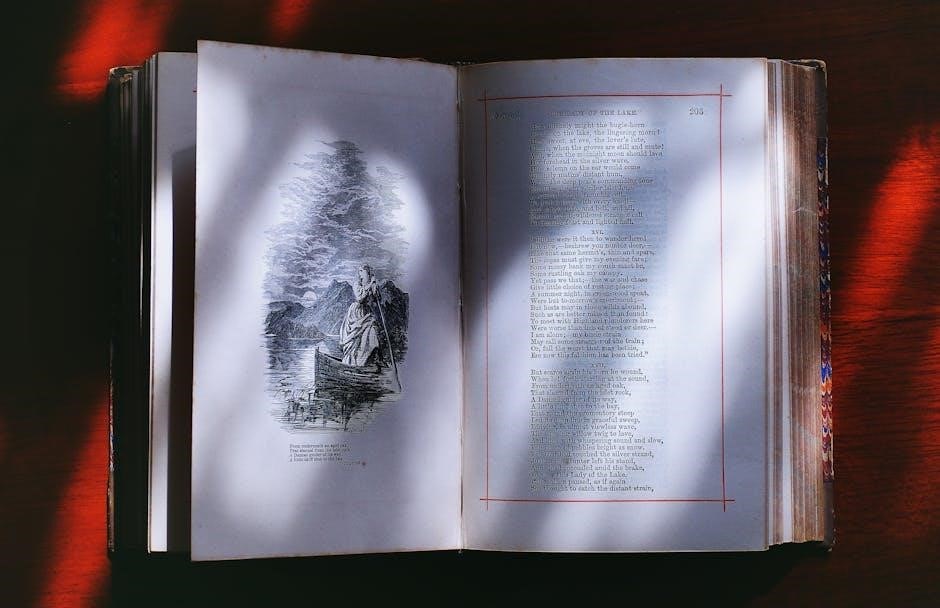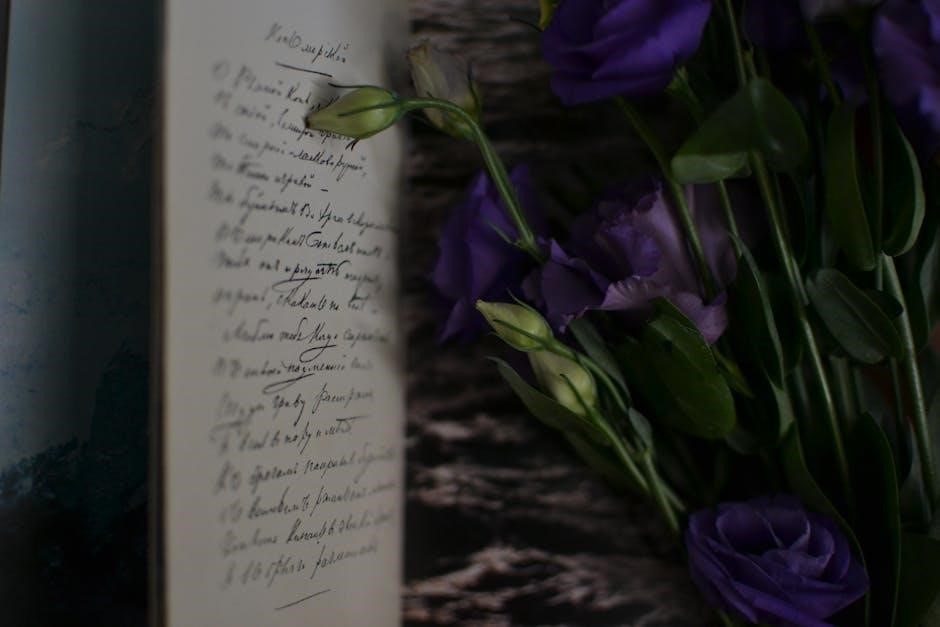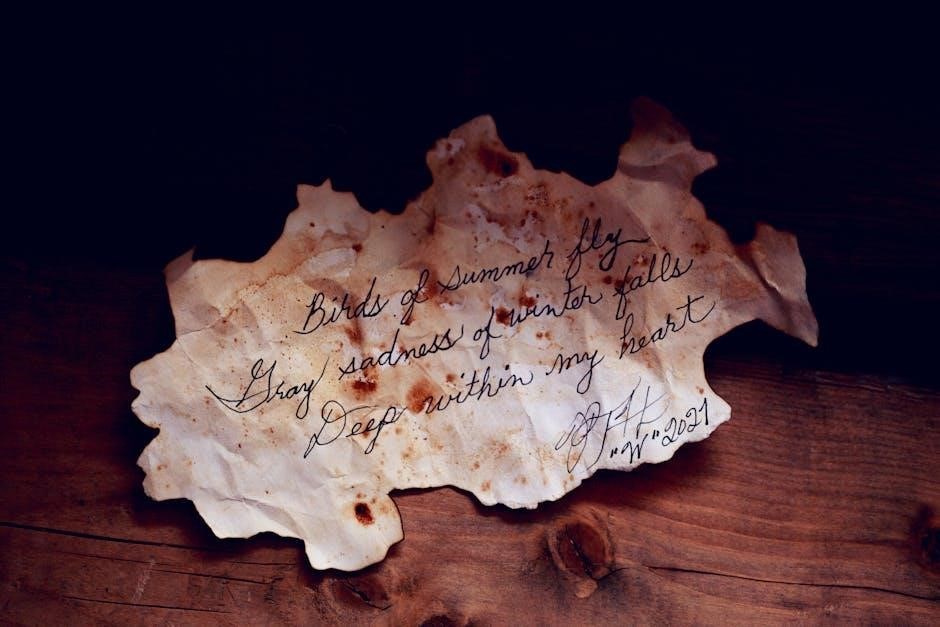Kubla Khan Poem PDF: An Overview
Samuel Taylor Coleridge’s “Kubla Khan” is widely available in PDF format, offering accessible means to explore its rich imagery․ Numerous online resources provide free downloads, enabling readers to delve into the poem’s themes of paradise and imagination with ease․
“Kubla Khan,” a fragment of a poem by Samuel Taylor Coleridge, stands as a testament to the power of imagination and the mysteries of the creative process․ Composed in 1797 but not published until 1816, the poem purportedly arose from an opium-induced dream, leaving it incomplete yet captivating․ It opens with the declaration of Kubla Khan’s decree to build a pleasure-dome in Xanadu, beside the sacred river Alph․ The poem then delves into a vivid depiction of the landscape, filled with both beauty and turbulent energy․ This landscape symbolizes the contrasting forces of creation and destruction, order and chaos, that reside within the human mind․ Despite its unfinished state, “Kubla Khan” continues to fascinate readers with its lyrical language, dreamlike imagery, and exploration of the sublime․

The Poem’s Central Themes
“Kubla Khan” explores themes of paradise, imagination, and the creative process․ The poem delves into the power of the human mind, contrasting idyllic visions with the untamed forces of nature․
Paradise and Imagination
The poem “Kubla Khan” vividly presents a paradise conjured through imagination․ Xanadu, with its “stately pleasure-dome,” represents an idealized space․ It is a realm where nature’s beauty and human artistry blend seamlessly, creating a sense of idyllic harmony․ This paradise is not merely a physical location․ It is a product of the speaker’s mind, shaped by dreams and visions․ The poem showcases the boundless capacity of imagination to construct realms of unparalleled beauty and wonder․ It also highlights its power to create an escape from the mundane realities of existence․ It is a testament to the human spirit’s ability to envision and realize utopia․
The Power of Creation
“Kubla Khan” delves into the profound power of creation, exploring both artistic and natural forms․ Kubla Khan’s decree to build a “stately pleasure-dome” exemplifies human creativity, aiming to shape the environment into a desired vision․ The poem also celebrates nature’s creative force through descriptions of the sacred river Alph, which flows through caverns to a sunless sea․ The interplay between human and natural creation emphasizes the dynamic relationship․ It is a relationship between the artist and the world․ It reflects the ability to transform and give birth to something new and awe-inspiring․ The poem explores the essence of creative power itself․
Literary Devices and Imagery
“Kubla Khan” showcases rich literary devices and vivid imagery․ Coleridge employs symbolism, alliteration, and metaphors․ These elements create a dreamlike atmosphere․ The imagery of the pleasure-dome, gardens, and river contributes to the poem’s sensory experience․
Symbolism in “Kubla Khan”
In Coleridge’s “Kubla Khan,” symbolism plays a crucial role in conveying the poem’s deeper meanings․ The pleasure-dome represents the human imagination and the desire to create a perfect, self-contained world․ The sacred river Alph symbolizes the flow of creativity and the subconscious mind, running through the caverns of the unknown․
Xanadu, as Kubla Khan’s capital, embodies a utopian vision․ Yet it also hints at the transient nature of power and beauty․ The “sunless sea” may represent the limitations of human understanding․ It speaks to the vastness of the world․ These symbols enrich the poem’s exploration of creativity, nature, and the human condition․

Historical Context
“Kubla Khan” is set against the backdrop of the Mongol Empire and its legendary ruler․ Coleridge drew inspiration from historical accounts and travelogues․ This provides a glimpse into a world of opulence and power․
Kubla Khan and Xanadu
The poem “Kubla Khan” is deeply intertwined with the historical figure of Kublai Khan, the Mongol emperor, and his famed city of Xanadu․ Coleridge’s work paints a vivid picture of Xanadu․ This is a place of exotic splendor and immense power․ The “stately pleasure-dome” described in the poem symbolizes the opulence and grandeur associated with Kublai Khan’s reign․
Historical accounts, such as those by Marco Polo, likely influenced Coleridge’s vision, blending reality and imagination․ Xanadu represents a realm of both earthly delight and artistic inspiration, capturing the allure of the East in the Western imagination․
Availability of “Kubla Khan” in PDF Format
“Kubla Khan” in PDF format is readily accessible through various online platforms․ These digital versions allow students, researchers, and poetry enthusiasts to easily study and appreciate Coleridge’s iconic work․
Free Downloads and Online Resources
Numerous websites offer free PDF downloads of Samuel Taylor Coleridge’s “Kubla Khan,” making it easily accessible for study and appreciation․ These resources range from digital archives of classic literature to educational websites providing study materials․ Project Gutenberg, a well-known source for free ebooks, often includes “Kubla Khan” in its collection of publicly available texts․ Additionally, many university and educational websites provide PDF versions as part of their online literature anthologies or course materials․
Online poetry archives and literary databases also offer the poem in PDF format, often alongside critical analyses and annotations․ These platforms cater to students, researchers, and general readers interested in exploring the poem’s themes, symbolism, and historical context․
Analysis and Interpretation
Coleridge’s “Kubla Khan” has invited diverse analyses, exploring themes like imagination, creation, and the sublime․ Critics examine its fragmented nature, symbolism, and the poet’s creative process, often focusing on its rich imagery and dreamlike quality․
Critical Perspectives on Coleridge’s Poem
Critical interpretations of “Kubla Khan” vary widely, with some focusing on its autobiographical elements, linking it to Coleridge’s own experiences with opium and altered states of consciousness․ Others emphasize the poem’s exploration of the creative process, seeing it as a metaphor for the power and limitations of human imagination․
Some critics analyze the poem through a psychological lens, examining its dreamlike imagery and symbolic representations of the subconscious․ Still others focus on the poem’s historical context, considering its relationship to Romantic ideals and the exoticism prevalent in European literature of the time․ The poem’s fragmented nature remains a central point of discussion․

Educational Resources
Numerous educational resources exist for studying “Kubla Khan,” including study guides, annotated editions, and scholarly articles․ These materials provide context, analysis, and interpretation, aiding students and educators in understanding the poem’s complexities․
Study Guides and Annotations
For students delving into Coleridge’s “Kubla Khan,” study guides and annotated editions serve as invaluable resources․ These materials provide a structured approach to understanding the poem’s complex layers, offering insights into its historical context, literary devices, and thematic concerns․ Annotations clarify obscure references and allusions, while study questions prompt critical thinking and deeper engagement․
Online platforms and academic databases host a wealth of analyses and interpretations, further enriching the learning experience․ Such resources often include biographical information about Coleridge, exploring the circumstances surrounding the poem’s creation․ By utilizing these tools, students can unravel the mysteries of “Kubla Khan․”
Carefully curated study guides can transform a passive reading into an active exploration of poetic beauty․

The Poem’s Lasting Impact
“Kubla Khan” continues to inspire artists and writers․ Its vivid imagery and exploration of the subconscious have secured its place in literary history․ The poem’s influence can be seen across various artistic mediums․
Influence on Literature and Art
Coleridge’s “Kubla Khan” has profoundly impacted literature and art, sparking creativity across generations․ The poem’s dreamlike imagery and exploration of the sublime have resonated with writers, painters, and musicians alike․ Its themes of imagination, creation, and the exotic have inspired countless works․ Artists have visually interpreted Xanadu’s pleasure-dome, while writers have drawn inspiration from Coleridge’s fragmented vision․
The poem’s influence extends to modern media․ Its themes have been incorporated into films, music, and video games, demonstrating its enduring appeal․ “Kubla Khan” remains a touchstone for artistic exploration․ Its legacy continues to shape creative expression․
